The University of the Free State’s (UFS) autumn diploma and graduation ceremony took place this week in the Arena on the South Campus in Bloemfontein (formerly known as the Vista Campus). This arrangement has been made because of the large-scale renovations to the Callie Human Centre on the Main Campus.
Friday, 24 April 2009
Faculties of Health Sciences, Law and Theology Diploma ceremony
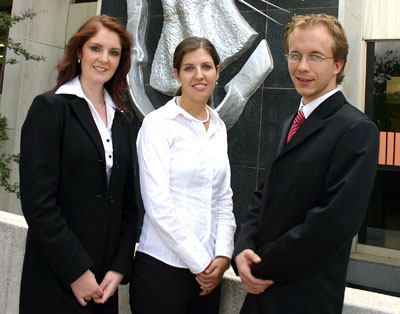
Law student’s achievement excels 80%
Four Law students obtained the LLB degree at this year’s autumn graduation ceremony of the University of the Free State (UFS) summa cum laude and were awarded the Moritz Bobbert Medal. They are from the left: Lezelle Olivier (80%), Albert Nell (91%) and Amanda du Toit (83%). LiFeng Chien were absent during the photo.
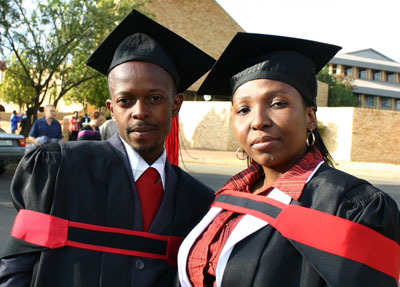
UFS awards degrees at autumn graduation ceremony
Today 331 students and five doctorates in the Faculties of Health Sciences, Law and Theology received their qualifications at this year’s autumn graduation ceremony of the University of the Free State (UFS). Michael Molahloe (left) and Mamokete Ntholeng both received their LL.B. degrees in the Faculty of Law.
Photo: Leonie Bolleurs
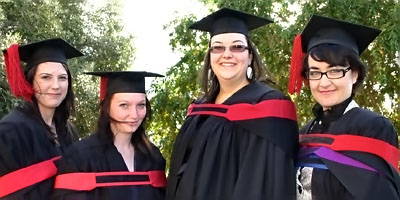
This year’s autumn graduation ceremony of the University of the Free State (UFS) was held on the South Campus. From the group of students that received their qualification from the Faculty of Law, is from the left: Janine Jonson, Anneska van der Spoel, Andrea Coetzer, and Jo-Mari Visser.
Photo: Leonie Bolleurs
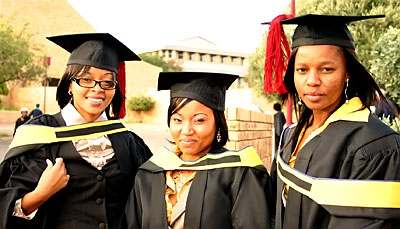
Students in Nursing receive their degree
A group of students from the Faculty of Health Sciences received their B.Soc.Sc. degree at this year’s autumn graduation ceremony of the University of the Free State (UFS). At the occasion were, from the left: Ruth Beukes, Basetsana Panana, and Dipontsheng Tsolo.
Photo: Leonie Bolleurs
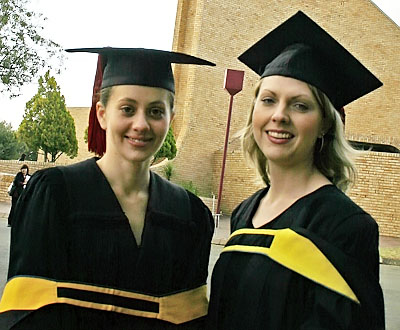
UFS Faculty of Health Sciences awards degrees
Liezl Swanepoel (left) and Heide van der Merwe received their BSocSC degrees at the University of the Free State’s (UFS) autumn graduation ceremony.
Photo: Leonie Bolleurs
--------------------------------------------------------------------------------
Thursday, 23 April 2009
Faculty of Natural and Agricultural Sciences & Chancellor’s Dinner
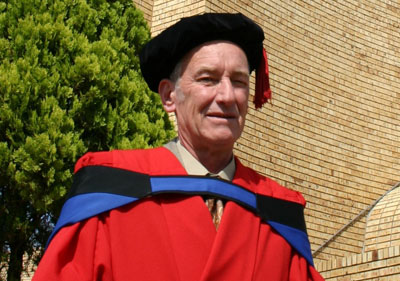
UFS awards unique doctorate
Dr Rodney Douglas, who had never obtained any formal undergraduate qualification, this week received a Ph.D. in Geography and Geology during the autumn graduation ceremony of the University of the Free State (UFS). The name of his thesis is “A new perspective on the geohydrological and surface processes controlling the depositional environment at the Florisbad archaeozoological site”. He had four papers published in journals that were related to his thesis. He obtained his South African Museums Association Diploma in Biology in 1988 and his M.Sc. in Environmental Biology at the University of Natal, Durban in 1992. He was accepted as a Master's degree student at that university based on research that he had conducted on, amongst others, the diets of reptiles. He has been working at the Department of Herpetology at the National Museum, Bloemfontein since 1984, where he holds the post of Principal Museum Scientist and Head of Department.
Photo: Leonie Bolleurs
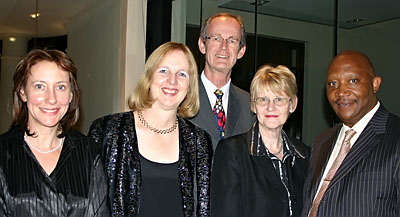
Chancellor’s Dinner: UFS honours doctoral students
Last night, the University of the Free State (UFS) honoured students who had received their Ph.D. degrees at the autumn graduation ceremony this past week, at the Chancellor’s Dinner. A total of 25 doctorates were awarded during the respective ceremonies. Attending the occasion were, from the left: Dr Annemarie Kühn, Ph.D. in Chemistry, Prof. Jeanet Conradie, Department of Chemistry at the UFS and Dr Kühn’s promoter, Prof. Teuns Verschoor, Acting Rector of the UFS, Prof. Corene de Wet, Department of Comparative Education and Education Management at the UFS, and Dr Mafu Rakometsi, Chief Executive Officer of Umalusi and former head of the Free State Department of Education who received a Ph.D. in History. Prof. De Wet is Dr Rakometsi's co-promoter and the late Prof. Leo Barnard, former Head of the Department of History at the UFS, who passed away at the beginning of April 2009, was his promoter.
Photo: Leonie Bolleurs
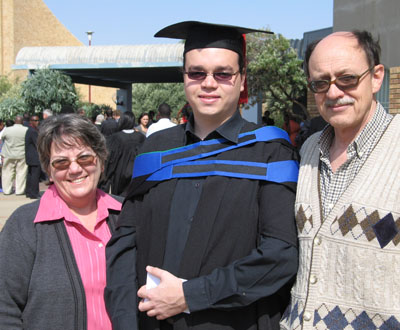
Mrs Annemarie Kilian, Mr Willem Kilian (BSc. Hons) and Prof Stephanus Kilian
Photo: Mangaliso Radebe
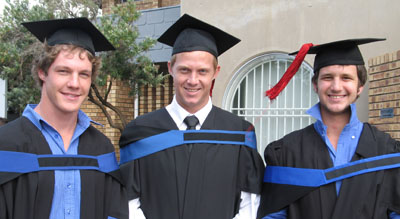
Mr Jaco van der Merwe, Mr Renico Pretorius and Mr Rion Terblanche (all BSc. Quantity Survying)
Photo: Mangaliso Radebe
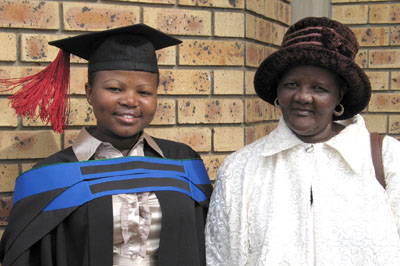
Ms Mamakoanyane Amelia Shata (BSc. Genetics and BSc. Hons. Plant Molecular Biology) and Mrs Maente Adelinah Shata.
Photo: Mangaliso Radebe
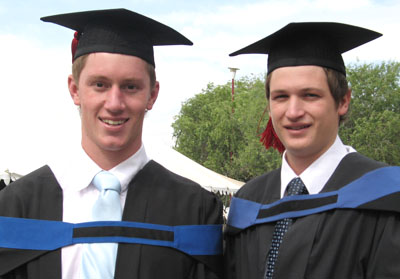
Mr Maurice Ambrose and Mr Owen Monk (both BSc. Quantity Survying).
Photo: Mangaliso Radebe

Ms Tobeka Mehlomekhulu (Lecturer: Department of Geography), Mr Neo Mokgosi (BSc. Hons. Genetics) and Ms Nwabisa Mehlomekhulu (BSc. Hons. Food Science).
Photo: Mangaliso Radebe
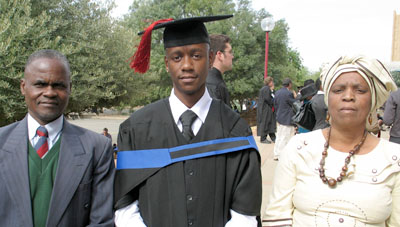
Mr John Mdane, Mr Fana Mdane (BSc. Information Technology) and Mrs Agnes Mdane
Photo: Mangaliso Radebe
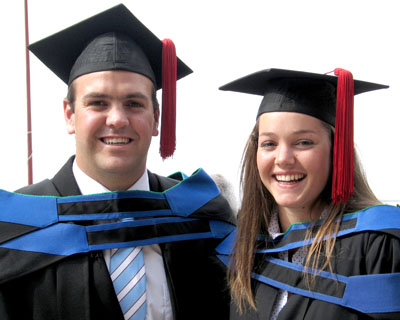
Mr Kevin Vermaak (BSc. Hons. Geohydrology) and Ms Michelle Steenkamp (BSc. Hons. Geology).
Photo: Mangaliso Radebe
--------------------------------------------------------------------------------
21 April 2009
Faculty of Economic and Management Sciences
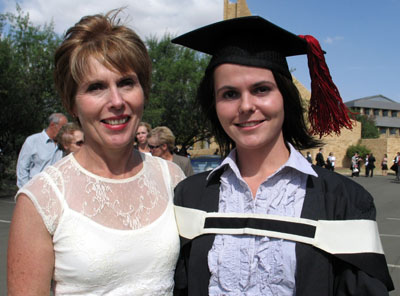
Prof. Magda Fourie's daughter graduates
Nadia Fourie, daughter of Prof. Magda Fourie, former Vice-Rector: Academic Planning at the UFS and now Vice-Rector: Teaching at Stellenbosch University, received the B.Com. Law degree.
Photo: Lacea Loader
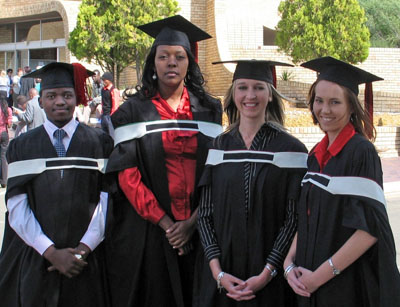
724 degrees were awarded during the ceremony of the Faculty of Economic and Management Sciences. Here are, from the left: Simon Serutla, B.Com. Accounting, Lourencia Hamuaka, B.Com. Honours in Financial Economics and Investment Management, Sunet Opperman, B. Accounting, and Yolandi Greyling, B. Accounting.
Photo: Lacea Loader
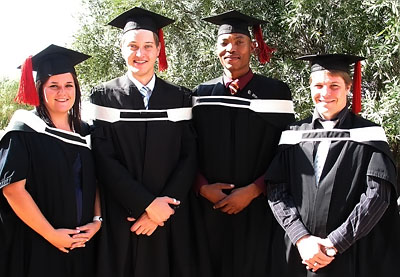
Students in the Faculty of Economic and Management Sciences graduated this week during the University of the Free State's (UFS) autumn graduation ceremony. Altogether 724 degrees were conferred. Here are, from the left: Marie-Louise Lombard, B.Com. Law, Adriaan van der Merwe, B.Com. Law and member of the Student Representative Council (Legal and Constitutional Affairs), Basanio Ncike, B.Com. Economics, and Richard Schooling, B.Com. Banking.
Photo: Lacea Loader
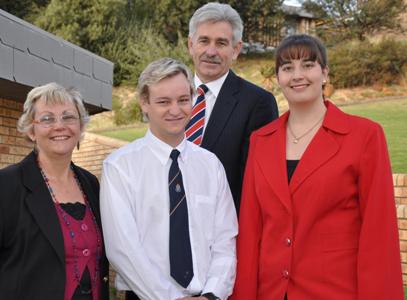
Center for Accounting honours top achievers
The Centre for Accounting at the University of the Free State (UFS) honoured the top ten students in the third-year B.Com. and B.Com. Hons. programmes respectively during this week's autumn graduation ceremony. Here are, from the left: Prof. Ronell Britz, Chairperson of the centre, Nils Kotze, first place in the B.Com. third-year group, and Madri Victor, first place in the B.Com. Hons. group; back: Prof. Hentie van Wyk, Programme Director: Accountant Training.
Photo: Stephen Collett
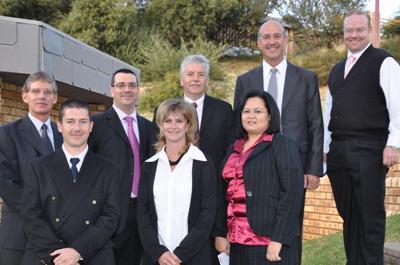
Accounting firms in Free State help with recognition of top achievers
Accounting firms in the Free State have contributed to a fund at the University of the Free State’s (UFS) Centre for Accounting to give recognition to top achievers in the third-year programme for the B.Com. and B.Com Hons. degrees respectively this week. It is evidence of the good relationship that exists between the Centre and the South African Institute for Chartered Accountants (SAICA), Free State. Here, from the left, are: Mr Pieter Clase, CoetzeeSmit Chartered Accountants, Mr Oswald Wentworth, KPMG, Mr Ettienne van Niekerk, PricewaterhouseCoopers, Herman Leach, Gobodo Inc. Chartered Accountants, and Mr Stefan Strydom, Havenga, Rossouw & Viljoen; front: Mr Ian Smit, Enslins Bloemfontein, Ms Thelma Crossman, Mazars, and Ms Daphline O'Brien, Ernst & Young.
Photo: Stephen Collett
--------------------------------------------------------------------------------
20 April 2009
Faculty of Education, Faculty of the Humanities.
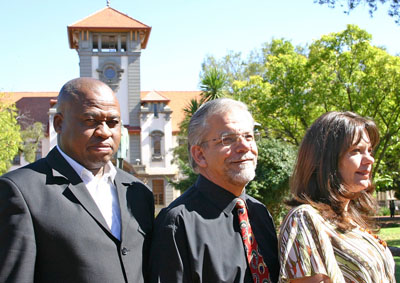
CHESD awards 15 masters degrees
A group of 15 students received the Structured M.A. (Higher Education Studies) of the Centre for Higher Education Studies and Development (CHESD) at this year’s autumn graduation ceremony of the University of the Free State (UFS). This is the biggest group in the centre's history to be awarded master’s degrees, while four of the students received distinctions. Also of interest is that six of the 15 students already have doctoral degrees. At the occasion were, from the left: Dr Dipane Hlalele, Qwaqwa Campus, Ms Liesl Hoare, Central Univeristy of Technology, Welkom Campus (best achiever), and Dr Fanus van Tonder, Programme Director: Higher Education Studies and Research, CHESD. Ms Hoare received the Deans medal in the Faculty of the Humanities as the best master’s graduate student at the graduation ceremony. At the faculty’s prize function she also received the Kovsie-Alumni Trust award as the best M.A student in the faculty. She also received the CHESD Prize for the best achievement in the Structured M.A. (Higher Education Studies).
Photo: Leonie Bolleurs
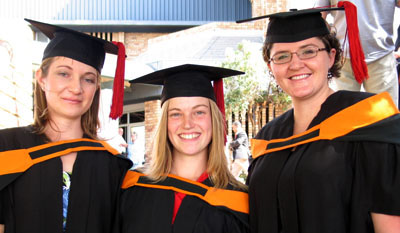
UFS awards degrees at autumn graduation ceremony
Five hundred and eighty six degrees and nine doctorates were awarded this week during this year's autumn graduation ceremony on the South Campus of the University of the Free State (UFS) to students in the Faculty of the Humanities. At the occasion were, from the left: Nicola Bekker, Madré van der Merwe and Esté Scholtz. All three the ladies received the qualification B.A. Language Practice.
Photo: Lacea Loader
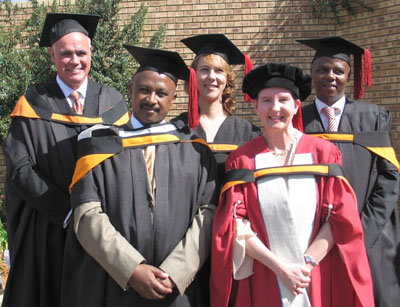
This year’s autumn graduation ceremony of the University of the Free State (UFS) is held on the South Campus in Bloemfontein. Today a group of students from the Programme: Governance and Political Transformation in the Faculty of the Humanities received their qualification. From the left, front are: Dr Tania Coetzee, Head of the Programme: Governance and Political Transformation, and Mr Itumeleng Liba, Chief Operation Officer at CENTLEC; back: Mr Kennett Sinclair, Vice-Chairperson of COPE in the Northern Cape, Ms Nicole Joannou, Goldfields Business and Catering, and Mr Tembeni Lobe from Bloemfontein.
Photo: Lacea Loader
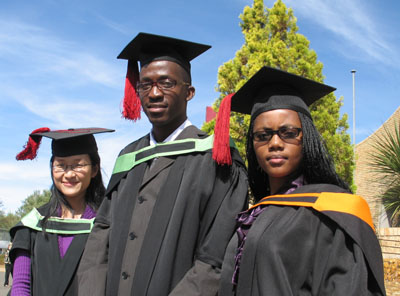
Some of the students who received their qualifications during this week's graduation ceremony of the Faculty of the Humanities were, from the left: Shu-Jung Chan, B.Mus. Hons., Brian Gxavu, B.Mus., and Mpolokeng Lepote, B.A. Media Studies.
Photo: Lacea Loader
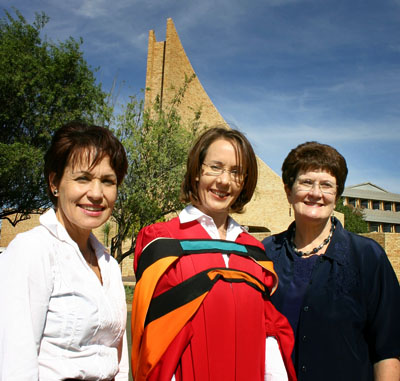
UFS’s CHESD awards doctoral degree
Ms Mardi Delport (middle), Assistant Director: Media and Communications at the Central University of Technology received her Doctoral degree at this year’s autumn graduation ceremony of the University of the Free State (UFS). The title of her thesis is: “An internal communication model for the Central University of Technology, Free State as a multi-campus institution”. With her are her promoter Prof. Driekie Hay (left), Vice-Rector: Academic Planning, and her co-promoter, Prof. Annette Wilkinson (right) from the Centre for Higher Education Studies and Development (CHESD) at the UFS.
Photo: Leonie Bolleurs